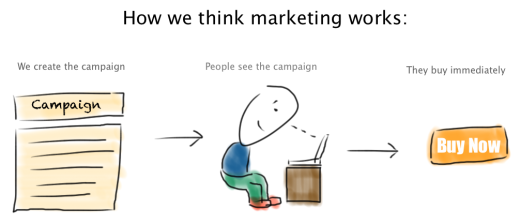
If you’re selling your time as a freelancer, or selling your own products, you’ve probably already realized you need to put nearly as much effort into marketing as you do into your work.
Getting people to know who you are and what you do is part of the process if you want to make your living independently, and to do this well, you need to be loud.
Why self marketing is important
People won’t find your work because it’s good. There’s too much noise online for the signal to get through just because it’s good. You need to be both good and loud.
As writer and digital creator Justin Jackson points out with this clever illustration, we tend to think about marketing as a linear process that’s clearly defined:

But in reality, this is a more likely process for a new customer:

When I say ‘loud’, I mean you need to let people know about your work. And as you can tell by looking at the image above, you need to tell people in lots of different ways about your work. Because seeing your work, and your name, over and over is what makes it stick.
You might have heard of the ‘rule of seven’ sometimes used in marketing. The idea is that the majority of people who will eventually buy from you need seven ‘touches’, or points of contact with your brand or product before making a purchase.
It’s unlikely that the first time you tell someone about your work they’ll be perfectly positioned to buy:
- In a situation where they can read/watch/listen to your pitch
- In a situation where they can purchase immediately
- Looking for a solution to the exact problem you’re solving
Rather, you’ll probably reach people in one of those circumstances at a time. But as you build up touches over time, you’ll eventually hit all three for the same customer and they’ll purchase from you. But if you just make your work and keep quiet about it, you’d have to be incredibly lucky for that to happen.
“Instead of spending all your time working on yourself and your craft, spend a little time figuring out who your audience is, what’s valuable to them and how you can foster a continued relationship with them.” Paul Jarvis
Paul’s advice is relevant to this discussion for two reasons:
- You need to know your audience to be able to provide value to them.
- You need to know your audience to be able to tell them about your work.
Number two may not be obvious, but here’s why it’s important: if you don’t know your audience, you can’t find them. You don’t know where to advertise (do they hang out on Facebook or Twitter or Pinterest or Tumblr?). You also don’t know how to talk to them.

Customers like being spoken to in their language. Using your customers’ language shows you truly understand their problems, which means you’re more likely (in the customers’ minds) to have a solution.
If you don’t know your customers, you could be turning them off through your wording without even realizing it.
‘Does anyone care about this?’ and other questions you shouldn’t be asking
Before you’re ready to shout about your work, you need to feel confident in what you’ve created. Whatever you’ve created, it needs to provide value—otherwise you’re not giving people any reason to buy, use, read, or otherwise care about your work.
Having said that, once I’ve decided to write a blog post, record a podcast, or build an app I never ask myself the question, ‘does anyone care about this?’ I do ask myself questions like ‘Could I improve this?’, ‘Could this be better?’, and ‘Are there useful takeaways in this?’
Asking if anyone cares calls into question the very core of what you’re working on. And as someone who does creative work, that’s very dangerous. Creative work doesn’t fit into a well-defined box. It requires some risk-taking, some experimenting, some rule-bending, or boundary-testing.
And making things that don’t fit into well-defined boxes is scary. It makes us vulnerable to judgement from others, which may be one of the hardest things in the world to do willingly.

So here’s what I do: I start with something I care about. If I think something I’m writing is interesting, that means I’d read it if someone else wrote it. Chances are, there are at least a couple of other people online who will read it if I write it.
I don’t want to create work that’s useless. I don’t want to fill up the internet for no reason. Nor do I want to be so overwhelmed by uncertainty that I stop creating, stop learning, and stop improving my skills.
To keep creating without falling into existential disarray I’ve learned to be brave and start from a base assumption that if I care about my work at least one other person probably does too, so it’s worth finishing.
When you’re scared, do it anyway
Publishing is hard. It’s really scary. Launching is scary, too.
Putting yourself out there (which is what we do when we make our work public) is scary and hard but you have to do it. The trick is not to overcome the scariness of launching, but to do it despite the fact that you’re scared.
For a long time I’ve been cursed with an inflated sense of my own potential but nothing to show for it. Nobody else agrees with me that I’m capable of amazing things because they haven’t seen any proof. I don’t need any more proof than what’s in my head, but others do—and rightly so.
So I need to publish. I need to launch.
I could wait around until I’ve improved my skills and learned more and studied how the pros get things done. But I might never be convinced that I’m ready (sound familiar?).
So I had to start launching before I was ready.

I started by publishing a new blog post every week. Every week I found something to write about and I sent it out into the world.
But I wanted more people to know about my work, so I had to be louder. I had to find more touch points. So I started a weekly newsletter.
This is more scary than publishing a blog post, in some ways, because an email is very personal. Each person on my mailing list gets an email from me every week, asking them to read my work. If I asked myself if anyone cared before writing that newsletter each week, I’d never send it.
Next I launched a product I wasn’t sure about. I labeled it an experiment to make it less scary but it still took guts to launch it.
I delivered the product to people who were paying for it for about three months. And I shut it down because I didn’t enjoy it. But hey, I launched something. In the future I can launch something else. I know I can, and now other people know I can.
“We all start in the same place: no money, no resources, no contacts, no experience. The difference is that some people — the winners — choose to start anyway.” James Clear
How to get started being loud
So you want to get started. You’re ready to be brave and go for it.
Your process will differ, because sharing your work is a personal process, but hopefully these ideas might help.
1. Start with what you care about
As I mentioned before my go-to is to work on stuff that interests me. At the very least, even if nobody likes it, or even if I fail to launch it, I won’t be bored while I’m making it.

If you’re interested in what you’re doing, you’ll always start with an audience of one. That’s a lot better than starting with zero.
If someone asks me whether anyone cares about what I’m working on, I can usually tell them honestly that I’d read this if someone else wrote it, or I’d use this app if someone else built it.
It also helps that choosing things I care about means I’m always working in-line with my values.
You can find a surprising amount of confidence in what you do by starting with things you care about.
2. Set a schedule
Designer and author Paul Jarvis and I have this part of the process in common. “Sharing can be draining,” he says, “So I schedule sharing when I’ve got the energy and am feeling amped up to do it.”
Before I set a schedule for my blog posts, I would rarely find the courage to create something new and follow it through until it was out in the world. There’s so much effort involved in that, and so much conviction needed to not give up before you’re done. A schedule forces me to do this on a regular basis.

Another benefit of working to a schedule is creating more touch points with your potential customers. If you launch or publish something new every week, that’s more than 50 possible touch points in one year.
3. Start small
I started with weekly posts on my blog. Then I added a weekly newsletter. Then a premium newsletter product. I stuck to writing, because that’s where my strengths lie.
Recently I started a podcast with my co-founder, but it took a long time for me to be brave enough to branch out into that new medium.
“Whether it’s writing, video, audio, painting, dance, whatever—find the medium you’re most comfortable with and do most of your sharing in that way. And then sometimes, push against the mediums you don’t think you’re as good at, in order to grow.” Paul Jarvis
Start with whatever makes you feel the most comfortable. Playing to your strengths will give you more confidence, and that’s exactly what you need to start putting your work out into the world despite the worry of what people will think of it.
If your business relies on selling your time or your products, you need to share what you do with the world. Not just with your paying customers, but with a broader audience who might end up paying you one day, or sending a friend your way.

Don’t forget that everyone finds this process scary. Even people who’ve spent years building up a loyal fanbase find this scary, because they have the added pressure of living up to the hype of everything they’ve done before.
It’s okay to be scared, or unsure, but you need to find a way to share your work despite that.
Read Next: How to start your freelance career and be your own boss
Image credit: Shutterstock, , Justin Jackson, Wyman H
This post first appeared on the Crew blog.
Get the TNW newsletter
Get the most important tech news in your inbox each week.





